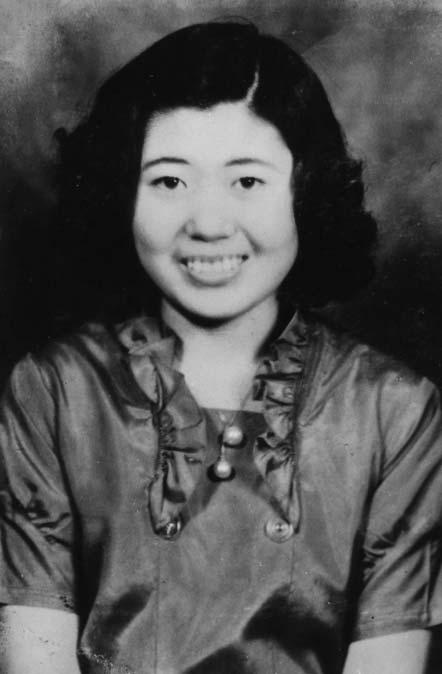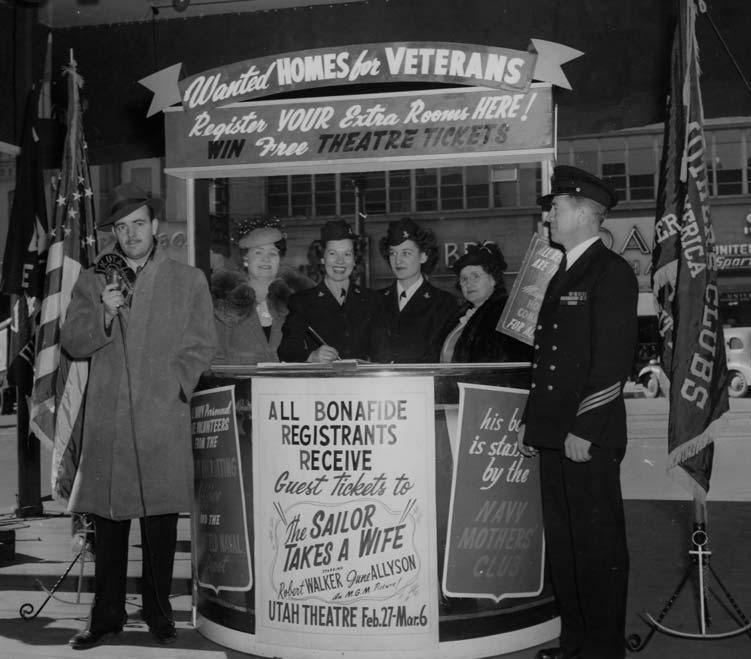
50 minute read
Utah and World War II
Utah and World War II
By ALLAN KENT POWELL
The years 1941-1945 were unique in American history as the nation fought two simultaneous colossal wars—one against Nazi Germany and Fascist Italy in North Africa and Europe, and another against the Japanese Empire in the Pacific. In the fight against Germany, the United States became allies with the Soviet Union which had been attacked by the German forces in June 1941 less than six months before the Japanese attack on the United States naval fleet at Pearl Harbor, Hawaii, on December 7, 1941. But the United States was a relative late comer to the World War that began at least as early as September 1, 1939, with the German invasion of Poland or even as early as the winter of 1931-32 with the Japanese occupation of Manchuria.
Known as World War II to distinguish it from the “Great War,”World War I, that decimated Europe between 1914 and 1918, this second great military and naval struggle of the twentieth century left more than twenty-two million military and perhaps as many as thirty million civilians dead in the most violent conflict in recorded history. The war also ushered in the nuclear age with the dropping of atomic bombs on the Japanese cities of Hiroshima and Nagasaki in August 1945. But the war also gave hope for a more democratic and free society both at home and in the war torn countries around the world.

The end of the war brought a housing shortage for returning veterans. This initiative to help find homes for discharged veterans was held in front of the Utah Theatre on Main Street in Salt Lake City on February 26, 1946.
UTAH STATE HISTORICAL SOCIETY
On the eve of war, Utahns, like the rest of the nation, were perhaps more fixed on the intense economic struggle they had endured during the past decade of the Great Depression and greatly unaware of the threat to their country of approaching war.
War, however, did not come as a total surprise for the United States.The 1930s brought unrest and a series of crises in Europe and in the Far East. In 1940 Congress passed the Selective Service Act, the first peace time draft that required young men between the ages of twenty-one and thirty-six to register. Later in the year, Congress authorized the President to call the National Guard into federal service for a year of training.The first National Guard divisions were called up on September 16, 1940, and by June 23,1941, all National Guard units were on active duty.
The 4,016 enlisted men and 156 officers of the Utah National Guard were called up on March 3, 1941, and sent to San Luis Obispo, California, as part of the 40th Infantry Division that included units from Salt Lake City, Ogden, Brigham City, Garland, Spanish Fork, Fillmore, Richfield, Beaver, Cedar City, Pleasant Grove, Bountiful, Logan, Manti, Nephi, Springville, St. George, and Vernal. Following training in California, many of the Utah guardsmen departed for the Philippine Islands on December 6, 1941, but when news of the attack at Pearl Harbor was received, the transport returned to San Francisco and the soldiers assigned to help defend a three hundred mile area of coastline from Santa Barbara, California, to the Mexican border. The 40th Infantry Division prepared for a possible Japanese invasion and also participated in the movement of Japanese American citizens from coastal areas to ten inland camps, including the Topaz Relocation Center northwest of Delta. 1
By June 1941 more than 1.3 million men and women were serving in the United States military including approximately 7,000 Utahns. Defense spending in Utah rapidly increased and Utah’s unemployment rate, which had reached 36 percent during the height of the depression, dropped accordingly.
Enrollment at Utah’s colleges and universities offered another indicator of the coming war as enrollment in the fall of 1941 dropped from 10 to 25 percent below the previous year. At the University of Utah registration for the 1941 fall quarter was 3,665 or 19 percent less than the 4,085 students who registered for the previous fall quarter. University administrators pointed to the high paying defense jobs and increased enlistment in the armed forces as the reasons for the decline. 2
Utah’s coal mines, which had worked under a greatly reduced schedule during most of the 1930s, now swung into full production with three eight hour shifts mining coal twenty-four hours a day and operators scrambling to find miners to fill all the shifts. Similar activity occurred in Utah’s metal mines as well.
On the Navajo reservation the Navajo Nation Tribal Council passed a resolution in 1940 declaring “…that the Navajo Indians stand ready as they did in 1918 to aid and defend our government and its institutions against all subversive and armed conflict and pledge our loyalty to the system which recognize minority rights and a way of life that has placed us among the greatest people of our race.” 3
Utah was destined to play a vital role in the United States war effort for a number of reasons. First, Utah’s isolated mountain and desert location, seven hundred miles from the Pacific Ocean, gave it safety from any threat of Japanese attack. Given the surprise attack on the American naval fleet in Hawaii and the fear of attack or sabotage along the West Coast, inland security was of primary consideration among wartime planners.
Second, Utah’s Wasatch Front was considered an excellent location for logistics support operations because it was far enough inland to be safe from potential enemy attacks and it was equidistant from the three major West Coast shipping points of Seattle, San Francisco, and Los Angeles. Utah was well connected to all major Pacific Coast ports as well as strategic locations to the east by transcontinental railroads, highways, and an emerging national airway system. 4 The value of Utah’s location was recognized after World War I when the War Department decided to store most of its unused munitions away from the Atlantic coast. Some 15 percent of the unused munitions were sent to a new depot known as the Ogden Arsenal while 25 percent were left on the eastern seaboard and 60 percent were sent to Savanna, Illinois. 5
Third, the large areas of unoccupied federal land could be used for artillery and bombing training without threat to the civilian population. The large tracts of flat, open land along the Utah-Nevada border coupled with excellent weather conditions of little rain or snow and clear days, made the Wendover area an ideal location for flight and bombing training.
Fourth, Utah’s treasure of natural resources including coal, copper, and iron ore, and the extractive industry for these resources could shift easily to wartime production demands. Fifth, Utahns were considered well-educated, intelligent, dedicated, and hard-working, all important qualities in evaluating the potential work force. Sixth, Utah seemed as well prepared as any other location to absorb both military and civilian newcomers who came because of the war. Seventh, Utah’s business and political leaders aggressively sought the establishment and expansion of military and industrial facilities critical to the war effort. 6 Consequently, where the federal government spent an average of $188 per capita nationally for new industrial plants, in Utah the amount was $534 per capita. 7
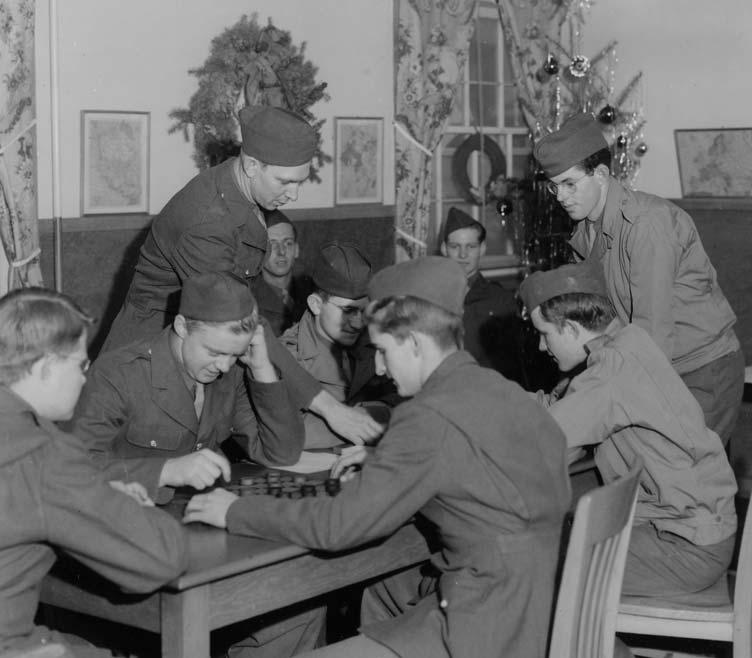
SHIPLER COLLECTION, UTAH STATE HISTORICAL SOCIETY
Previously established military installations, including Fort Douglas founded in 1862 and the Ogden Arsenal established in 1921, took on expanded roles as part of the war effort. The Army’s Ninth Service Command relocated from San Francisco to Fort Douglas shortly after the attack on Pearl Harbor and the fort came to life as the military nerve center for Washington, Oregon, California, Utah, Idaho, Arizona, and Montana. For almost all Utahns as well as residents from surrounding states, Fort Douglas was their first and last experience with the army as the post served as a reception center for incoming soldiers and a separation center for those being discharged from military service. 8
Thirteen new military and naval installations—including Hill Field, the Tooele Army Depot, Clearfield Naval Supply Depot, the Utah General Depot, the Kearns Army Air Base, Wendover Air Base and the Dugway Proving Grounds—were established in the state. 9
Industrial expansion leaped forward with the construction of the Geneva Steel Works in Orem and the accompanying expansion of iron and coal mining in the state. Construction of the works on the eastern shore of Utah Lake began in November 1941 and extended to December 1944 employing approximately 10,000 workers, many from surrounding towns and others from outside the county and state. Steel production began in February 1944 and in 1945 the facility employed 4,200 steel workers. 10
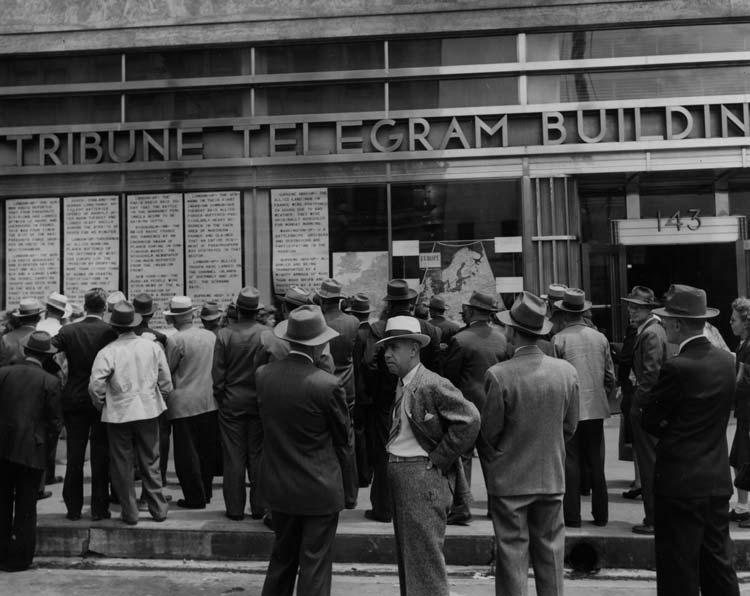
Utahns crowd in front of the Salt Lake Tribune Building on June 6, 1944, to receive the latest word on the allied invasion at Normandy.
SHIPLER COLLECTION, UTAH STATE HISTORICAL SOCIETY
Utah was well represented as the opening act of World War II for the United States played out in the usually tranquil waters of Hawaii’s Pearl Harbor. Jack Mead, who joined the navy in December 1937 during his senior year at Jordan High School, was on board the USS Farragut when the attack occurred. Before the ship was able to fight its way through the channel and out of Pearl Harbor, Mead witnessed first hand the horrors of the attack: “I saw the last big explosion of the Arizona and it was like a tin can exploding just one big explosion, and it was so hard it made your nose and ears bleed. I saw all these poor guys trying to get out of that burning water. I saw guys running around trying to stuff their entrails back into their stomach. Men trying to run on their bloody stumps.” 11
Another Utahn, Walter Staff of Salt Lake City, was on board the USS Oklahoma when it was attacked and remained trapped in the submerged battleship for two days until freed by rescue crews. Staff was the last of thirty-two sailors to be rescued from the Oklahoma which carried a crew of 2,400 sailors of whom 450 died in the attack. 12
Throughout Utah, news of the December 7, 1941, attack on Pearl Harbor spread quickly. Like other Americans, Utahns can still recall where they were and what they were doing when the news of the attack at Pearl Harbor reached them. Marie Cowley remembered she and her new husband Pete had attended church then gone riding with two other couples. They returned to prepare dinner and spend the evening playing cards and games. Pete, who had gone to his parent’s home nearby to get the cards and games, sprinted back to the house insisting that they turn on the radio because, “We are at war.” Marie and the others did not believe him complaining he was just making up a story to fool them. He insisted that the Japanese had bombed Pearl Harbor. “Everybody said, ‘Where’s Pearl Harbor?’ We turned on the radio and sure enough we were at war.” 13
Monday December 8, 1941, was a day of fear, anger, and resolve. Russell Neiland, who joined the navy in May 1941, was assigned back to his hometown to the Salt Lake City Naval Recruiting Station. He recalled, “The next day after Pearl Harbor you couldn’t get near the Federal Building for people wanting to come in and join.They were just swamped, and all of the armed forces were the same way.” 14 Gloria Smith, a student in Payson remembered,“…the students sat in a half circle around a small table with an oval radio on it. I remember thinking of the possibility of being bombed and killed here, in Payson, as the people in Hawaii were. I was frightened and confused.” 15
As precaution against saboteurs and spies, guards were assigned to watch industrial plants and railroad property. For a time, private planes were grounded and the broadcasting of local weather reports was halted because “such information was considered highly valuable in planning hostile aircraft action.” 16
As war engulfed Utah and the nation, religious leaders faced the dilemma of “renouncing war and proclaiming peace” while supporting the American war effort. The First Presidency of The Church of Jesus Christ of Latter-day Saints, in its message on “The War,” issued in early October 1942, called upon world leaders “...to bring this war to an end, honorable and just to all....The weeping mothers, the distraught and impoverished wives, the fatherless children of the world, demand that this be done. In this way only will enduring peace come; it will never be imposed by armed force.” But the proclamation also “...condemn[ed] the outcome which wicked and designing men are now planning, namely; the worldwide establishment and perpetuation of some form of Communism on the one side, or of some form of Nazism or Fascism on the other.” 17
Although 2,400 Americans lost their lives during the attack on Pearl Harbor and severe damage to the American Pacific Fleet occurred, no invasion followed. Instead Japanese forces landed in the Philippine Islands on December 8, 1941.
Thomas R. Harrison, who received his commission as a second lieutenant in the United States Army during the June 1941 University of Utah commencement ceremonies, arrived in the Philippines in August 1941. Harrison survived the infamous Bataan Death March that American soldiers endured after the general surrender on April 9, 1942. As he saw comrades die at the hands of their Japanese captors or from exhaustion, malnutrition, and sickness, Harrison faced the question of his own mortality and how he might survive what many considered a hopeless fate.
The task of defeating Japan in the vastness of the Pacific was daunting. Dale E. Winn, a soldier from Tooele County, reflected on the letters he received full of good cheer and predicting that before long the war would be over and he would be coming home.

SALT LAKE TRIBUNE COLLECTION, UTAH STATE HISTORICAL SOCIETY
Each Japanese held island was fraught with deadly danger. Don Bush, also from Tooele County, recounted one Pacific island invasion:
There was no island in the Pacific Theatre on which the fighting was more severe or brutal than Iwo Jima. George Platis, in a letter to his parents living in Price, noted that the Japanese had held Iwo Jima since 1891 and over a period of fifty years had built a series of fortifications and tunnels making it the “Gibraltar of the Pacific.” He sized up the task to take the island in his letter, “To knock out all of those fortifications with air and naval power is impossible, and only the men who go onto the island can wipe them out, and then only with long and bitter fighting.” 21
George Wahlen of Ogden joined the navy at age eighteen, was trained as a corpsman, and landed with the Fifth Marine Division on Iwo Jima February 19, 1945. For his bravery and valor during the fighting on Iwo Jima, Wahlen was awarded the Congressional Medal of Honor. 22
Utahns fought in North Africa and throughout Europe. A number of young Utah skiers were attracted to the Tenth Mountain Division, which underwent intensive ski training for the anticipated mountain warfare in Italy and Germany. Before the creation of the Tenth Mountain Division, the army sent paratroopers from Fort Benning, Georgia, to Fort Douglas where local ski instructors, including Dick Nebeker, tried to make skiers of paratroopers. At Alta in Little Cottonwood Canyon they were taught the snowplow technique and were instructed if they could not stop to fall to the rear on their hip. Nebeker recalled: “It was horrifying to watch them pick up too much speed snowplowing down the steepest part of the face underneath the Collins lift then revert to their jump training and try and grab their knees and roll forward instead of taking the spill to the rear.” 23
Later, the army decided it would be more practical to make soldiers out of skiers rather than skiers out of soldiers. By this time Nebeker had been drafted and when the opportunity presented itself to join the ski troops training at Camp Hale, Colorado, rather than the infantry in Kansas or Texas, it was an easy choice for the avid skier. On his first patrol in Italy, he and his fellow skier-soldiers of the Tenth Mountain Division tried to creep and crawl after encountering the enemy, but found, “The tails of our skis made a give away noise, like dragging a stick along a picket fence….I remember laying my skis carefully down by a rock wall where I thought I’d retrieve them later….I never did find that pair of skis and never worried about it. We never fought on skis again.” 24
Another member of the Tenth Mountain Division, Rocco C. Siciliano a 2nd Lieutenant from Salt Lake City, wrote of his experience in Italy:
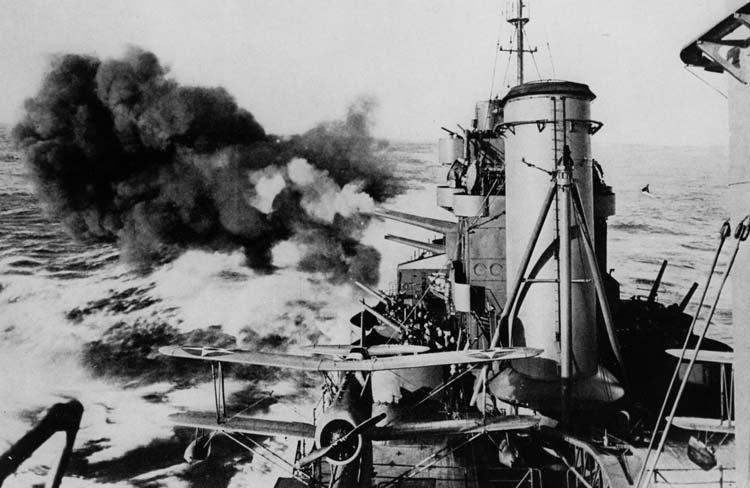
The main battery of the cruiser USS Salt Lake City fires at Wake Island in the Pacific on February 24, 1942.
UTAH STATE HISTORICAL SOCIETY
While Utah soldiers fought in the valleys and mountains of Italy, on the beaches and through the hedgerows of Normandy then on to Paris, then to the German border itself, and in the island hopping campaign in the Pacific, other Utahns served in the army air corps and navy. Airmen experienced their own version of the horror and dangers of war in the skies above France and Germany and over the Pacific. Alden P. Rigby, a native of Fairview in Sanpete County, became an ace fighter pilot winning the Silver Star for shooting down three German planes during the Battle of the Bulge. 26
For Grant Douglas Johnson, a native of Tropic in Garfield County and a member of a B-17 crew stationed in England, one mission over Berlin was especially tragic. He saw five airplanes shot out of the sky. “That night there were six men left in our barracks out of the sixty who left that morning.” 27
One who did survive was Spencer P. Felt of Salt Lake City. Flying out of Cerignola, Italy, to bomb an oil refinery just east of the Auschwitz concentration camp, Felt’s B-24 bomber was hit by antiaircraft flack and the ten-man crew was forced to bail out over German held territory. Rescued by Polish resistance fighters, the Americans were sent across to the Russian lines and after an arduous three month trip through Poland to Kiev then south to Odessa on the Black Sea and by ship to Istanbul and finally Egypt, Felt and his companions were turned over to American officials and returned to their home base in Italy. 28
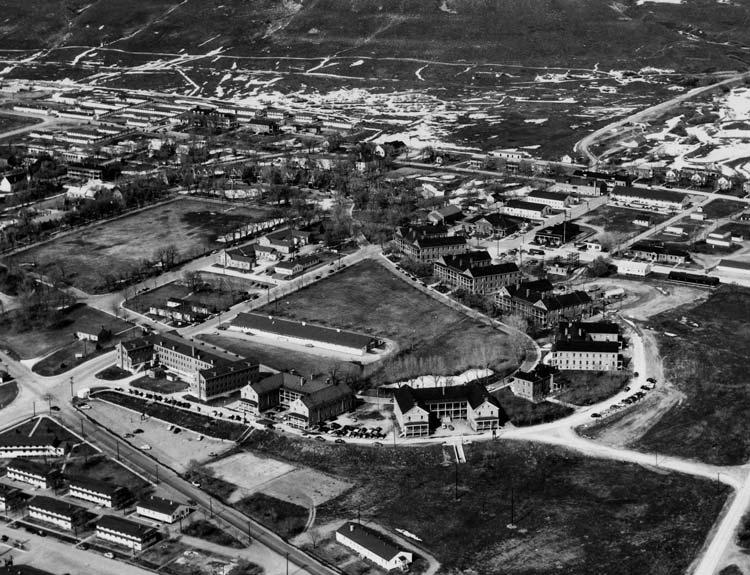
UTAH STATE HISTORICAL SOCIETY
While thousands of American families lost loved ones in the war, no family sacrificed more than the Alben Borgstrom family of Thatcher in Box Elder County. Five sons, including a pair of twins, enlisted in the armed services and four were killed in action. LeRoy, the oldest, was killed in Italy. Clyde, the second oldest, died on Guadalcanal. Rulon, one of the twins, was killed in France, while Rolon, the other twin and airplane tail gunner, was wounded during a mission and died of injuries in England. After the death of the four sons in a six-month period between March and September 1944, the Borgstroms requested that their last son, Boyd, who had been a Marine for three and a half years and had fought in the Pacific, be allowed to return home. The requested was granted. 29
Utah women also served in the military and made important contributions as nurses and in other non-combat assignments. Helen Kennedy of Randolph, Rich County, joined the army nurse corps after three of her brothers left for military service. She was sent to a hospital in England where she was made chief nurse with responsibilities for the care of thirty ill and injured soldiers. She related her wartime experience with the wounded.
Back in the United States the WASPs—Women Army Service Pilots— was organized to train women pilots to ferry bombers, fighters, and transport aircraft from the airplane factories to the air bases around the United States. June Lloyd Stephens, who took private flying lessons at the Salt Lake Airport and worked at the United Airlines desk in the Hotel Utah, was selected for the program and assigned to Sweetwater, Texas. The training was difficult and dangerous and thirty-eight women lost their lives while serving as WASPs. Stephens recalled one near fatal day during her training when the fuel line on her plane broke and sprayed oil all over the windshield. She returned to the airfield and landed the plane receiving high praise from her instructor. 31
Before the war was over, more than 10 percent of the state’s population saw military service. In June 19, 1945, the number of Utahns in uniform was 62,107, of whom 1,343 were women. Under the Selective Service Act of 1940, 127,602 Utah men between the ages of 18 and 37 registered for the draft by July 1945. Between October 1, 1940, and June 30, 1946, 41,950 men were inducted into the service and another 29,222 enlisted. Of the 3,660 who died during the war, 1,450 were killed in action. 32
The war affected life in Utah in many ways. The popular Saltair resort closed from 1943 to 1945 because of rationing and other shortages. Salt Lake City transportation officials also eliminated unnecessary trolley stops and traffic signals in order to save gasoline. 33 Gas ration cards meant that car owners were limited to less than three thousand miles a year while war workers, doctors and farmers could obtain coupons good for up to five thousand miles a year. 34
County fairs were cancelled and baseball leagues discontinued during the war. Even Utah’s traditional deer hunt was impacted by the war as ammunition was rationed and could only be purchased with adequate coupons. 35 The lack of men on college campuses led to innovative ways to
cope with the problem. At Weber State College in Ogden students sponsored a highly successful but unusual “Polygamist Prance,” “…where the women students asked men students for a date and the men could accept as many dates as each could 'haul' to the dance and entertain." 36 A co-ed at Brigham Young University "....suggested a system for rationing dates similar to the national program for rationing gasoline." 37
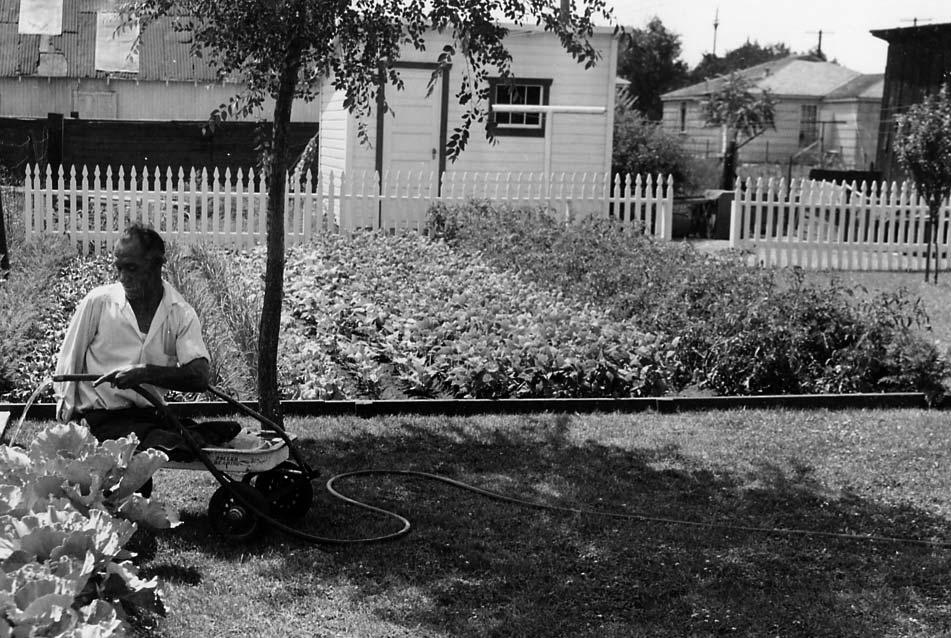
SALT LAKE TRIBUNE COLLECTION, UTAH STATE HISTORICAL SOCIETY
The problem of gas rationing is illustrated in the story of Russell Talbot of Panguitch who suffered an appendicitis attack. When the local doctor, Sims E. Duggins, determined that Talbot needed to be transported seventy miles to Cedar City for emergency surgery, a crisis developed. Dr. Duggins “…had used all his gas-ration stamps and the Talbot’s did not own a vehicle. In desperation, Memphis Talbot went through the town to gather stamps to fill Duggin’s gas tank, and the three of them finally took off for Cedar City for his emergency surgery.” 38
Doctors were scarce in rural Utah. Until Sims Duggins moved to Panguitch shortly before the war ended, residents of south and central Utah had to travel from eighty to one hundred and fifty miles to see doctors in either Richfield or Kanab. 39 When a draft notice threatened to take the only doctor available to the five thousand residents of remote San Juan County, a petition with 1,400 signatures was sent to Washington in a successful initiative to keep Dr. Wesley L. Bayles in the county. 40
In Utah’s communities a “war mentality” prevailed. Even physical fitness was seen to contribute to the war effort. When the Wasatch School District offered a ladies gym class on Wednesday afternoons to give homemakers the opportunity for exercise, the Wasatch Wave, in support of the endeavor, proclaimed, “At this time it is every patriotic citizen’s duty to build and maintain the highest degree of physical fitness.” 41
Children participated in collection drives and war bond drives. During newsreels at the movies, “…we would all yell and jeer at the Japanese and Nazis and clap and cheer wildly when a Kamikaze plane was brought down.” 42
Jack Douglas Barton was undoubtedly one of those who cheered during such newsreels. In 1943 his parents moved from their Uintah Basin ranch to the Salt Lake Valley where his father worked in a meat-packing house and his mother at the Remington Small Arms plant. With both parents working swing shifts, the younger Barton was left alone in the evenings. “I remember a friend and I went to an all-night movie house, and for ten cents we got in and stayed ‘till one in the morning. I saw a double feature, a newsreel, and a cartoon.” 43
Barton and other children made contributions to the war effort collecting tin cans, newspapers, and milkweed pods. He also recalled:
School children were also used to work in the sugar beet fields under the supervision of teachers and transported to the fields in school buses. In some locations school officials opted to hold Saturday classes in March and April so that school would end on April 30 and the students could assist with spring planting. 45
The shortage of men on farms and ranches meant that women had to do the work formerly done by husbands and brothers. There were undoubtedly many rural women, like Gwen Seely of Wayne County, who “…remembered having to take two of her younger children with her on the tractor when she went out to bail hay.” 46

At Utah military installations, women workers repaired airplanes, tanks and other vehicles damaged in battle.
SALT LAKE TRIBUNE COLLECTION, UTAH STATE HISTORICAL SOCIETY
In many rural counties the number and size of farms increased significantly during the war. In Millard County, for example, the number of acres farmed increased from 287,000 acres in 1940 to more than 458,000 acres in 1945 while the size of farms increased as well from nearly 300 acres in 1940 to about 450 acres in 1945. 47
The establishment of a parachute factory in Manti significantly impacted the employment condition in Sanpete County. Officials contacted local officials asking for the names of women between the ages of eighteen and forty who might fill one of the 350 new jobs. Women worked forty-eight hours a week with two shifts - one from 6:00 a.m. to 2:30 p.m. and the other 2:45 p.m. to 11:15 p.m., six days a week." 48
Many young women from rural Utah left their towns and farms for work at one of the defense installations along the Wasatch Front. The percentage of women in the work force leaped from 17.6 percent in 1940 to 36.8 percent by 1944. 49 Dorothy Lemon was one of an estimated 24,000 women who took advantage of employment opportunities in local war industries. Lemon, a thirty-eight year old mother of three, started out working at the Remington Small Arms Factory for fifty-one cents an hour and when the plant closed she was earning eighty-four cents an hour—a good wage for women at the time, but still less than the amount paid to men for the same work. 50 Other women, like Julia Platt Lutz, fit the “Rosie the Riveter” model to a “T.” After graduating from Weber High School in May 1942, she was trained as a sheet metal worker at Weber State College and then given a job at Hill Field. She recalled her war work:
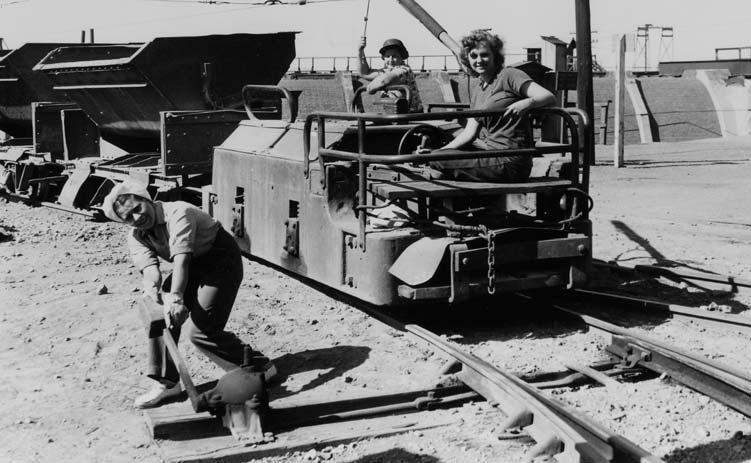
During the war women performed many jobs formerly done only by men.Here they switch tracks for an ore train.
SALT LAKE TRIBUNE COLLECTION, UTAH STATE HISTORICAL SOCIETY
Work could be physically, mentally, and emotionally demanding. Margaret Atwood Herbert graduated from Pleasant Grove High School in 1941, attended LDS Business College in Salt Lake City, and took a job at the army’s Bushnell Hospital in Brigham City as secretary to five doctors. Reflecting on her services she recalled:
The patients at Bushnell had much support from the citizens of Brigham City who helped find places for family members to stay who came to visit and, in the case of the Knudson family—owners of the Idle Isle Restaurant, offered a free steak dinner to patients who walked through the front door with their artificial legs for the first time. 53
The Utah Minute Women were organized under the War Production Board of Utah to educate civilians about the importance of wartime conservation measures and to undertake salvage drives to collect everything from scrap metal, tin cans, rubber, waste paper, and cooking fat to nylon hosiery and other needed items. Utah was the first state to complete its Minute Women organization with a force of over eight thousand Minute Women and five thousand school age children recruited as “Paper Troopers.” The importance of the Minute Women was made clear by Wilworth Walker, chairman of War Services for Salt Lake City, who warned in 1942:“War, if won, will be won by men on the front, if lost, will be lost on the homefront.” 54
Money was critical to the war effort and Utahns, like their fellow Americans, were expected to purchase their quota of war bonds during the drives that were held throughout the war. Communities, counties, and states competed with each other to see who would be the first to meet their quota and to reach the highest per capita bond subscriptions. Local war heroes, celebrities, and politicians including Vice President Harry S. Truman, Jack Dempsey, and the comedy team of Abbott and Costello among many others made appearances in Utah to promote the sale of war bonds. 55
The Utah war effort was augmented by an unlikely source of help–enemy prisoners of war. More than eight thousand German and seven thousand Italian prisoners of war came to Utah between 1943 and 1945 where they labored and met Utahns in the warehouses and shops at Tooele Depot, Ogden Defense Depot, Clearfield Depot, Hill Field; in the wards at Bushnell Hospital; and on farms in Cache Valley, Box Elder and Weber Counties, Utah Valley, and Sanpete and Sevier Counties. 56
Like most of the rest of the country, Utah confronted questions of race and civil rights for the first time. While other questions arose relating to Native Americans and minority groups-many of whom came to the state as farm workers or miners, the two greatest challenges seem to involve the Japanese Americans and African Americans.

SHIPLER COLLECTION, UTAH STATE HISTORICAL SOCIETY
With the outbreak of war against Japan, several questions arose regarding the Japanese Americans who could be found in Utah’s urban areas, its mining towns and camps, and even rural locations such as Box Elder County and Gunnison Valley. How would Japanese Americans already living in Utah be treated? How would Utahns respond to attempts to bring Japanese Americans into their communities? What would be the Utah experience with one of the ten relocation camps, the Topaz camp northwest of Delta, established by the federal government in the Western states to house the more than one hundred ten thousand Japanese Americans relocated from the West Coast of the United States under Executive Order 9066? And finally, what would be the Japanese Americans’ contribution to the war effort?
Although the experience of Japanese Americans already in Utah varied from community to community and situation to situation, in general, it was one laced with suspicion, sometimes fear, and often hostility. For Sego Takita Matsumiya, who was enrolled in the nursing program at St. Mark’s Hospital in Salt Lake City, the days following the attack on Pearl Harbor were filled with uncertainty and trauma.“I got spit on the bus. I heard people behind me say, ‘They ought to send all Japs to the Pacific Ocean and drown them.’”When she tried to enlist in the army’s nursing program the recruiting officer told her “...there is no place in the American Army for a Japanese nurse.” But when she returned to the hospital she was reassured that she was much needed in the hospital and there would always be a place for her there. In Carbon County, where Sego’s father worked as a coal miner, the Japanese miners were not allowed in the mines out of fear that they would commit acts of sabotage. In addition, her father had his radio, .22 rifle, and camera confiscated, before he moved to a farm near Brigham City. 57
The movement of Matsumiya and other Japanese Americans to Box Elder County led to efforts to prevent more Japanese from purchasing land and moving to the county. 58 When the threat loomed that Japanese Americans might move into the Kanab area, the Kane County Standard editorialized, “Kane county definitely did not want any of the yellow Japs migrated, settled or employed in its communities....With great respect we honor the heritage our fathers and our forefathers gave unto us, by the grace of God. Never, have the records shown that Kane county has ever had a Japanese resident.” 59
In Iron County Lowell H. Sherratt arranged for the relocation of ten Japanese families from the West Coast to his family-owned Page’s Ranch located twenty-eight miles west of Cedar City. While the families were not welcome by everyone, “Ten-year-old Akiyoshi Iwata made friends among farm boys living nearby; he later said that he never felt rejection during the four war years his family lived in Iron County.” 60 However in Utah County bullets were fired at the residences of Japanese Americans on at least two occasions and one fourteen-year old girl was struck. Five youths were arrested for shooting into the buildings and some citizens reminded others “...that the Japanese there were American citizens as we were.” Under such volatile conditions Japanese Americans were careful and circumspect. Yukus Inouye, who owned a small farm on Highland Bench, recalled that he and other Japanese Americans did not mingle with each other. “We did not get together....We felt that any association with each other would raise suspicion.” LDS Church President, Heber J. Grant, alarmed at the intolerance shown toward Japanese Americans reminded members of the Mormon church, “Americans who are loyal are good Americans whether their ancestors came from Great Britain or Japan....Let us, therefore, endeavor to banish these foolish prejudices from our natures and let us attempt to see that all good and loyal Americans are treated as such.” 61

Japaneses Americans depart train and board busses for the Topaz Relocation Camp during World War II.
PEOPLES OFUTAH COLLECTION, UTAH STATE HISTORICAL SOCIETY
The establishment of the Central Utah Relocation Center, later named the Topaz Relocation Center and located near Topaz Mountain about fifteen miles west of Delta, brought approximately eight thousand Japanese Americans from the San Francisco area to Utah. As early as January 1942, federal government officials met with Delta residents to discuss the possibility of locating the camp in Millard County. By June 1942 the camp was under construction and opened on September 11, 1942. It did not close until October 1945. In 1943 some residents were allowed to relocate to other areas in Utah to farm or do other work. A number of groups did leave Topaz for a farm labor camp in Utah County, some to work on a farm near Green River and on the Charles Redd Ranch at LaSal, others worked in the sugar beet fields, and one group was sent to mine coal at the Dog Valley Mine south of Emery. 62
In January 29, 1943, President Franklin D. Roosevelt announced that volunteers would be accepted in a Japanese American combat unit. One hundred five volunteers from Topaz served on active duty. Fifteen Japanese American soldiers from Topaz were killed during fighting in Italy and southern France. One, Thomas Tako, received the Silver Star for his valor. 63

PEOPLES OFUTAH COLLECTION, UTAH STATE HISTORICAL SOCIETY
Not all eligible young men at Topaz volunteered for military service. Those who refused to indicate a willingness to serve in the armed forces if ordered to do so and swear “unqualified allegiance to the United States of America” were sent to Tule Lake, California. 64
Jim Tazoi from Garland joined the Japanese American 442nd Regiment. He was awarded the Distinguished Service Medal for his heroism during the fighting in France where he was shot in the chest–the bullet passing clear through his body to lodge in the radio that he was carrying on his back. Tazoi returned to the United States for treatment at Fitzsimmons Hospital in Denver. When his parents, who spoke no English, traveled from Box Elder County to Denver by train to see their son, their daughter prepared a set of cards with questions in Japanese on one side and English on the other that her parents could use to ask basic questions and directions. 65
Another Box Elder County born Japanese American, Shoji Watanabe, served as an interpreter in the Philippines, where he interviewed hundreds of Japanese prisoners of war including General Tomoyuki Yamashita and General Massaharu Homma and two Japanese soldiers who had lived in Utah before the war. 66
The African American population of Utah numbered only 1,235 in 1940. However, the war brought more than double that number to the state—mostly as soldiers, but some as defense and construction workers— so that the 1950 census recorded 2,729 African Americans living in Utah. When a group of African American workers from Denver, Colorado, arrived to assist in the construction of the Geneva Steel Mill, separate barracks were built for them. Dick Anderson, a local labor representative, recalled the difficult situation when one of them, a veteran of the war, showed him his battle wound then complained that “Two clerks walked away and left me standing” when he tried to purchase goods in a local store. With Utah county businessmen unwilling to remedy what Anderson and the African American workers saw as a grave injustice,“…a few courageous people set up a store at the old Geneva resort so these men could buy things.” 67
Emma Helwing, an Austrian Jew who, after a harrowing escape from Vienna in December 1938, landed in Salt Lake City in October 1940 and became active in the war effort through volunteer service at the Jewish Community Center, the Red Cross, and the USO. She recalled:
Myron Q. Hall, a young clerk at the Hotel Utah recalled the bitter irony of the hotel’s segregation policy when, with vacant rooms available, he had no choice but to deny a room to a decorated black officer who had lost an arm in the war and oblige him to spend a long night on a seat in the hotel lobby. 69
While Utah’s soldiers and sailors faced grave danger on the battlefields and on board America’s war ships, workers at home faced injury and death as well. In the 1940s there was no more dangerous occupation than that of a coal miner. During the years 1941 through 1945, 140 miners died in Utah’s coal mines, most of them in Carbon County where 85 county residents died in war service during the same time period. 70 The number of dead coal miners was nearly 10 percent of the total of 1,450 Utahns killed in action during the same time period.
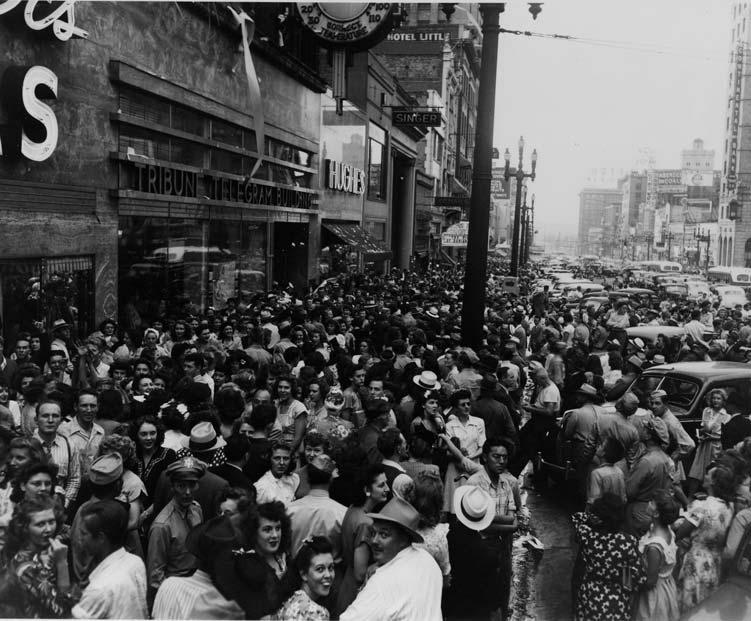
Salt Lake City celebrates V-J (Victory in Japan) Day on August 14, 1945.
SHIPLER COLLECTION, UTAH STATE HISTORICAL SOCIETY
Like the rest of the nation, Utah celebrated the end of the war with enthusiasm and relief that the long ordeal was over. Nearly every community held some kind of spontaneous celebration. Many were similar. Residents learned of the event by radio broadcasts or when a siren began to sound. People embraced and kissed each other. High school bands formed up to march up and down Main Street, often leading a parade of horn honking cars and trucks. Some of the cars continued their honking throughout the day and into the evening with some dragging noise-making articles such as garbage cans behind them. Some cars carried effigies of Japanese rulers and leaders that were tossed into a huge bonfire later in the day. Street dances were held. Businesses closed. In Provo, Brigham Young University students lit the “V” part of the block “Y” on the mountain. One young woman remembered the a large celebration held at Payson Memorial Park. “I suppose there were many wonderful speeches made that day, but the things I remember the most were the songs that were sung: ‘God Bless America’ and ‘The Star Spangled Banner.’ I had chills going up and down my spine as I listened to these songs and saw people all around me crying tears of joy for the war’s end.” 71
After 1945, Utah would never be the same place it was before December 7, 1941. The war experience had affected men, women, children, families, and communities in incalculable ways. Some rural counties experienced significant losses in population because of military service and wartime work. For example in Wasatch County, Heber City lost 7 percent of its population while Midway lost 4 percent. In Rich County, the population declined from a high of 2,028 in 1940 to 1,673 in 1950.The population of Duchesne County dropped 9 percent from 8,948 to 8,134 while Garfield County suffered a more than 20 percent decline between 1940 and 1950. In contrast, the population of Salt Lake City grew from 211,623 in 1940 to 274,895 in 1950. 72
The defense industry expanded during the war to become a pillar of the state’s economy.The educational benefits offered through the G.I. Bill gave returning veterans the opportunity to earn college degrees and with them the potential to move into high paying jobs not only in Utah, but around the country. The influx of veterans necessitated the expansion of Utah’s colleges and universities providing the faculty and buildings for subsequent generations to enjoy easy access to and strong encouragement for higher education. In the aftermath of the war, hundreds of refugees came to Utah from many nations of the world. Finally, the legacy of military service would echo during the rest of the twentieth century as new generations of Utahns fought in Korea,Vietnam, Iraq, and Afghanistan.
NOTES
Allan Kent Powell is the managing editor of the Utah Historical Quarterly
1 For a history of the Utah National Guard in World War II see Richard C.Roberts, Legacy:History of the Utah National Guard From the Nauvoo Legion Era to Enduring Freedom (Salt Lake City:National Guard Association of Utah,2003),204-81.
2 Ralph V.Chamberlin, The University of Utah:A History of the First Hundred Years 1850 to 1950 (Salt Lake City:University of Utah Press,1960),479.
3 Doris A.Paul, The Navajo Code Talkers (Philadelphia:Dorrance,1973),2-3.Approximately four hundred Navajo marines from Arizona,New Mexico,and Utah served in the Pacific Theater as “Code Talkers”during World War II.
4 Roger D.Lauinius,“Utah in World War II,”in Utah History Encyclopedia, ed.Allan Kent Powell(Salt Lake City:University of Utah Press,1994),645.
5 Thomas G.Alexander, Utah the Right Place:The Official Centennial History (Salt Lake City:Gibbs Smith Publisher,1995),340.
6 Utah’s Governor Herbert B.Maw successfully urged the state legislature in January 1941 to establish a Department of Publicity and Industrial Development to seek new war-related enterprises.John D. Christensen,“The Impact of World War II,”in Utah’s History,ed.Richard D.Poll,(Provo:Brigham Young University Press,1978) 497-98.
7 Alexander, Utah the Right Place,345.
8 A number of Utah communities have undertaken projects to record and collect the experiences of local veterans.These accounts and interviews are housed in local libraries and museums with duplicate copies of many of the oral history interviews available at the Utah State Historical Society.Statewide projects have been undertaken through the “Saving the Legacy:An Oral History of Utah’s World War II Veterans,”Project at the University of Utah’s American West Center,and the “Saints at War”Project at Brigham Young University.Excerpts from more than two hundred accounts have been published in Robert C.Freeman and Dennis A.Wright, Saints at War:Experiences of Latter-day Saints in World War II (American Fork:Covenant Communications,2001).Other World War II experiences of Utah veterans are included in Dennis Roy,Grant P.Skabelund,and Ray C.Hillam,eds. A Time to Kill:Reflections on War (Salt Lake City:Signature Books,1990);and Allan Kent Powell, Utah Remembers World War II (Logan:Utah State University Press,1991).
9 For accounts of these installations see the following articles published in the Utah Historical Quarterly between 1963 and 1966.Leonard J.Arrington and Thomas G.Alexander “They Kept ‘Em Rolling:the Tooele Army Depot,1942-1962,”31 (Winter 1963):3-25;Leonard J.Arrington and Archer L.Durham, “Anchors Aweigh in Utah:The U.S.Naval Supply Depot at Clearfield,1942-1962,”31 (Spring 1963): 109-26;Leonard J.Arrington and Thomas G.Alexander,“World’s Largest Military Reserve:Wendover Air Force Base,1941-63,”31 (Fall 1963):324-35;Leonard J.Arrington and Thomas G.Alexander,“Sentinels on the Desert:The Dugway Proving Ground (1942-1963) and Deseret Chemical Depot (1942-1955),”32 (Winter 1964):32-43;Leonard J.Arrington and Thomas G.Alexander,“Supply Hub of the West:Defense Depot Ogden,1941-1965,”32 (Spring 1964):99-121;Leonard J.Arrington,Thomas G.Alexander,and Eugene A.Erb,Jr.,“Ogden Air Materiel Area at Hill Air Force Base,1938-1965,”33 (Winter 1965):9-33; Thomas G.Alexander and Leonard J.Arrington,“Utah’s First Line of Defense:The Utah National Guard and Camp W.G.Williams,1926-1965,”33 (Spring 1965):141-56;Thomas G.Alexander,“Ogden’s ‘Arsenal of Democracy,’1920-1955,”33 (Summer 1965):237-47;Thomas G.Alexander,“Brief Histories of Three Federal Military Installations in Utah:Kearns Army Air Base,Hurricane Mesa,and Green River Test Complex,”34 (Spring 1966):121-37.
10 Christensen,“The Impact of World War II,”502.
11 “Jack Mead,”in Powell, Utah Remembers World War II,8.
12 “Walter Staff,”Ibid.,3-6.
13 “Marie Cowley,”Ibid.,194.
14 “Russell Neilan,”Ibid.,13.
15 Quoted in Richard Holzapfel, A History of Utah County (Salt Lake City:Utah State Historical Society and Utah County Commission,1999),236.
16 Ibid.,237.
17 The Deseret News, October 3,1942.
18 Thomas R.Harrison, Survivor:Memoir of Defeat and Captivity:Bataan,1942 (Salt Lake City:Western Epics,1989),103-104.For another excellent account of the Philippine surrender and prisoner of war experience see Gene S.Jacobsen, We Refused to Die:My Time as a Prisoner of War in Bataan and Japan,19421945 (Salt Lake City:University of Utah Press,2004).
19 Dale E.Winn,“Suntan & Fatigue:Life in 167 Field Artillery Battalion,4lst Infantry Division,”70-71, copy in the Utah State Historical Society Library.
20 Don E.Bush, Ten Who Were One:The True Story of 10 Teenagers in World War II, (Salt Lake City:Hawkes Publishing,1995),61-63.
21 “George Platis,”in Powell, Utah Remembers World War II,71.
22 “George Wahlen,”Ibid.,75-80.
23 “Dick Nebeker,”Ibid.,60-61.
24 Ibid.,66.
25 Rocco C.Siciliano, Walking on Sand:The Story of an Immigrant Son and the Forgotten Art of Public Service (Salt Lake City:University of Utah Press,2004),81-82.
26 “Alden P.Rigby,”in Powell, Utah Remembers World War II,85-88.
27 “Grant Douglas Johnson,”Ibid.,110.
28 Spencer P.Felt,Jr.,Ibid.,89-93.
29 Frederick M.Huchel, A History of Box Elder County,(Salt Lake City:Utah State Historical Society and Box Elder County Commission,1999),272-73.
30 “Helen Kennedy Cornia,”in Powell, Utah Remembers World War II,152-53.
31 “June Lloyd Stevens,”Ibid.,149.
32 Christensen,“The Impact of World War II,”509.
33 Linda Sillitoe, A History of Salt Lake County,(Salt Lake City:Utah State Historical Society and Salt Lake County Commission,1996),188-89.
34 Robert S.McPherson, A History of San Juan County,(Salt Lake City:Utah State Historical Society and San Juan County Commission,1995),336.
35 Richard C.Roberts and Richard W.Sadler, A History of Weber County,(Salt Lake City:Utah State Historical Society and Weber County Commission,1997),264;John D.Barton, A History of Duchesne County,(Salt Lake City:Utah State Historical Society and Duchesne County Commission,1998),273,and Jessie L.Embry, A History of Wasatch County,(Salt Lake City:Utah State Historical Society and Wasatch County Commission,1996),199.
36 Richard W.Sadler,ed., Weber State College…A Centennial History (Salt Lake City:Publishers Press, 1988),98.
37 Ernest L.Wilkinson,ed., Brigham Young University:The First One Hundred Years,Vol.2 (Provo:Brigham Young University Press,1975),342.
38 Linda King Newell, A History of Garfield County,(Salt Lake City:Utah State Historical Society and Garfield County Commission,1998),312.
39 Ibid.
40 McPherson, A History of San Juan County,276.
41 Quoted in Embry, A History of Wasatch County,201.
42 Quoted in Holzapfel, A History of Utah County,238.
43 “Jack Douglas Barton,”in Powell, Utah Remembers World War II,138-39.
44 Ibid.,139.
45 Sadler and Roberts, A History of Weber County,265;and Seegmiller, A History of Iron County,(Salt Lake City:Utah State Historical Society and Iron County Commission,1998),133.
46 Murphy, A History of Wayne County, (Salt Lake City:Utah State Historical Society and Wayne County Commission,1999),304.
47 Edward Leo Lyman and Linda King Newell, A History of Millard County,(Salt Lake City:Utah State Historical Society and Millard County Commission,1999),319.
48 Albert C.T.Antrei and Allen D.Roberts, A History of Sanpete County,(Salt Lake City:Utah State Historical Society and Sanpete County Commission,1999),267-68.
49 Antonette Chambers Noble,“Utah’s Rosies:Women in the Utah War Industries During World War II,” Utah Historical Quarterly 59 (Spring 1991):126.
50 “Dorothy Lemmon,”in Powell, Utah Remembers World War II,159.
51 “Julia Platt Lutz,”Ibid.,164.
52 “Margaret Atwood Herbert,”Ibid.,172-73.
53 “Verabel Call Knudson,”Ibid.,180.
54 Quoted in Katie Clark Blakesley,“Save ‘em,Wash ‘em,Clean ‘em,Squash ‘em”The Story of the Salt Lake City Minute Women,” Utah Historical Quarterly 71 (Winter 2003):43.
55 Murphy, A History of Wayne County,303-4;Holzapfel, A History of Utah County,255;Ronald G.Watt, A History of Carbon County ,(Salt Lake City:Utah State Historical Society and Carbon County Commission,1997,) 381;and Jessie L.Embry,“Fighting the Good Fight:The Utah Home Front During World War II,” Utah Historical Quarterly 63 (Summer 1995):264-65.
56 Allan Kent Powell, Splinters of a Nation:German Prisoners of War in Utah,(Salt Lake City:University of Utah Press,1989).
57 “Sego Takita Matsumiya,”in Powell, Utah Remembers World War II,226.
58 Huchel, A History of Box Elder County,275.
59 Martha Sonntag Bradley, A History of Kane County,(Salt Lake City:Utah State Historical Society and Kane County Commission,1999),247.
60 Seegmiller, A History of Iron County,132.Another group of fifteen Japanese American families from San Francisco,Oakland,Los Angeles,and Santa Barbara located at Keetley in Wasatch County after Fred Isamu Wada leased 3,500 acres of land from local mining officials for eight thousand dollars.When local school officials did not secure funding for a separate school for the forty-one elementary and high school students,they were permitted to attend Wasatch County schools.Embry, A History of Wasatch County,215-16.
61 Quoted in Holzapfel, A History of Utah County,238-40.
62 Jane Beckwith,“Topaz War Relocation Center,”in Allan Kent Powell,ed. Utah History Encyclopedia, 560-61.For accounts of Topaz internees working at various places in Utah see McPherson, A History of San Juan County,336;Edward Geary, A History of Emery County,(Salt Lake City:Utah State Historical Society and Emery County Commission,1996),303;and Holzapfel, A History of Utah County,238-40.For accounts of the Topaz War Relocation Camp and life there,see Sandra C.Taylor, Jewel of the Desert:Japanese Internment at Topaz (Berkeley:University of California Press,1993),and “Interned at Topaz:Age,Gender, and Family in the Relocation Experience,” Utah Historical Quarterly 59 (Fall 1991):380-94;Leonard J. Arrington, The Price of Prejudice:The Japanese American Relocation Center in Utah during World War II (Logan: Utah State University Faculty Association,1962);Newell and Lyman,A History of Millard County,321-27; Yoshiko Uchida,“Topaz City of Dust,” Utah Historical Quarterly 48 (Summer 1980):234-43;Wanda Robertson,“A Teacher for Topaz,Marian Robertson Wilson,” Utah Historical Quarterly 69 (Spring 2001): 120-38.
63 Newell and Lyman, A History of Millard County, 315.
64 Beckwith,“Topaz Relocation Center,”561.About fifty Japanese American internees labeled “trouble makers”by the federal government were housed in the former Civilian Conservation Corps Camp at Dalton Wells in Grand County from January 11 until April 23,1943.Richard Firmage, A History of Grand County,(Salt Lake City:Utah State Historical Society and Grand County Commission,1996),293-94;and Bruce D.Louthan and Lloyd M.Pierson,“Moab Japanese-Isolation Center,” Canyon Legacy,19:28.
65 “Jim Tazoi,”in Powell, Utah Remembers World War II,230-32.
66 “Shoji Watanabe,”Ibid.,233-36.
67 Quoted in Holzapfel, A History of Utah County,246.
68 “Emma Helwing,”in Powell, Utah Remembers World War II,206-7.
69 Sillitoe, A History of Salt Lake County, 193.
70 Thursey Jessen Reynolds,comp., Centennial Echoes From Carbon County (Price,UT:Daughters of Utah Pioneers,1948),33.
71 Quoted in Holzapfel, A History of Utah County,257-58.See other accounts of community celebrations in Embry, A History of Wasatch County,216-17;Sadler and Roberts, A History of Weber County,298; Pearl D.Wilson, A History of Juab County,(Salt Lake City:Utah State Historical Society and Juab County Commission,1999),236-37.
72 Embry, A History of Wasatch County,214;Robert E.Parson, A History of Rich County,(Salt Lake City: Utah State Historical Society and Rich County Commission,1996),293;Barton, A History of Duchesne County,275;and Newell, A History of Garfield County,308;and “Population,”Utah History Encyclopedia, 433.




